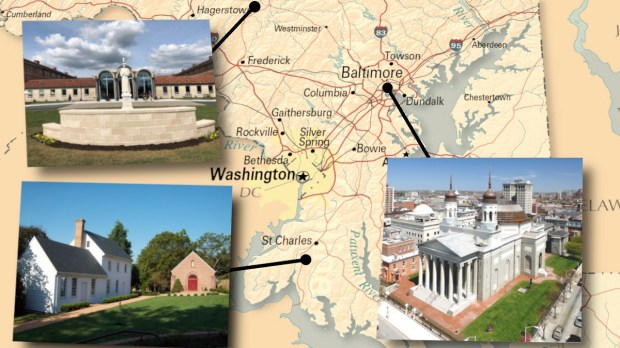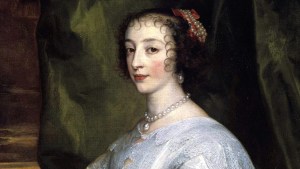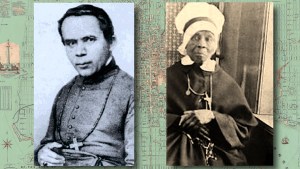Although it’s common knowledge that Maryland was founded as a refuge for Catholics and with an unusually high degree of religious toleration, you might be shocked to know just how hard-fought the Catholic presence was there.
The early history of Maryland can best be summed up like this: The Lords Baltimore said, “We are going to build a refuge for Catholics and people of minority faiths to enjoy religious freedom,” and all the neighboring colonies replied, “Oh no, you’re not.”
Before our sites, a little history lesson …
Surrounding states didn’t embrace the small Catholic colony; far from it! Anti-Catholic prejudice beleaguered it from its start in 1634. You can read all about it at Catholic Encyclopedia, and here are some of the wildest facts.
In 1644, residents of neighboring states attacked the province in a vessel named the Reformation:
[They] compelled Governor Calvert and some of the principal persons of the colony, including two of the Jesuit Fathers, to fly to Virginia, captured and burned St. Mary’s, destroyed valuable records, plundered and destroyed the residences of many of the inhabitants, especially the houses and chapels of the missionaries, and took Father [Andrew] White a prisoner in chains to London, where he had him indicted as a returned Jesuit priest, an offense for which death was the punishment. [Fortunately, he successfully argued in court that his return was not of his own will. He was not executed but was never allowed to return to Maryland as he desired.]
The Catholic colonists eventually regained their land, but a decades-long tug-of-war began between them and their Protestant neighbors who wished to expunge their presence. Puritans usurped Maryland in 1676 and by 1704, “Catholics were prohibited from practicing their religion; priests were debarred from the exercise of their functions; priests and parents forbidden to teach Catholic children their religion, and the children encouraged to refuse obedience to the rule and authority of their parents.”
Nightmarish discrimination
In 1718, Catholics were legally barred from voting and holding public office. In 1715 a law was adopted providing that if a Protestant should die leaving a widow and children, and his widow was Catholic or should marry a Catholic, her children were to be taken out of her custody and placed “where they might be securely educated in the Protestant religion… Without regard to sex or age the child or children should be put wherever the justice pleased. There was no appeal.”
This nightmarish discrimination continued until the Revolutionary War, when most of the Catholics in Maryland supported the American cause, while local Anglican clergymen were loyal to England. At that point, public opinion turned in favor of Maryland’s Catholics and the legal penalties on Catholics were lifted in 1776.
At last, in 1788 — more than 150 years after the first Mass was celebrated in what was intended to be a Catholic refuge — the pope finally established Baltimore as a see and appointed Rev. John Carroll its first bishop.
As you can see, the popular perception of Maryland as “the Catholic colony” is complicated and fraught with a painful history. Yet a strong tradition of Catholic belief has been present in Maryland since the early 1600s, and sure enough, it has many Catholic sites of special historical and spiritual significance.
1
Basilica of the National Shrine of the Assumption
The first Catholic cathedral built in the United States after the nation’s founding, the Baltimore Basilica opened in 1821 and was among the first major religious buildings constructed after the adoption of the U.S. Constitution.
Baltimore was the first archdiocese in the nation, and as it is the premier episcopal see, the archbishop of Baltimore has the right of precedence in the nation at liturgies, meetings, and Plenary Councils since 1859.
As a co-cathedral, the basilica is one of the seats of the Catholic Archdiocese in Baltimore, along with the Cathedral of Mary Our Queen. Considered the masterpiece of Benjamin Henry Latrobe, the “Father of American Architecture” and architect of the U.S. Capitol, the church is a popular visit for architecture enthusiasts.
While visiting the church you can also visit the Pope John Paul II Prayer Garden, as well as the museum that houses hundreds of artifacts and antiques that go as far back as the 17th century, including vestments of Cardinal Gibbons, letters between numerous presidents and archbishops, altar vessels and other artifacts. Guided tours are available and include the upper church, undercroft, Our Lady Seat of Wisdom Chapel, Crypt, and the Prayer Garden upon request.
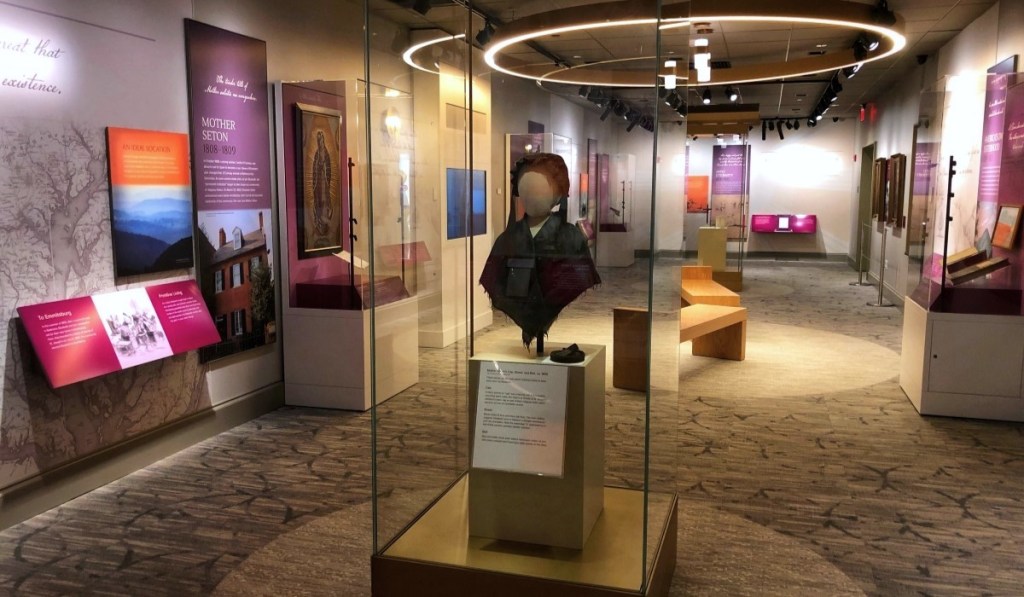
2
National Shrine of St. Elizabeth Ann Seton, Emmitsburg
There is so much to see and do at this gem of a site! First pray at the awe-inspiring Basilica of St. Elizabeth Ann Seton, where the saint is entombed in the Altar of Relics. Then visit the museum, where Mother Seton’s extraordinary life and enduring legacy come to life through rarely seen artifacts, personal writings, digital interactive exhibits and hands-on activities for all ages.
See the Stone House that was her first permanent home, the old cemetery where she was originally buried, the White House where she lived for 11 years, and the Seton Legacy Garden. The grounds also include the Daughters of Charity residences, Archives, cemeteries, and Villa for residential care of the retired Sisters.
There is a wonderful living history program at the historic St. Joseph’s School. Visitors can engage historical interpreters, who portray a student or a Sister from Mother Seton’s time.
The site also offers a robust program of memorable special events, such as Candlelight Tours before Christmas; cemetery walks in October; the immersive “Academy Alive” reenactment weekend in the spring; and the annual “Sea Services” pilgrimage where members of U.S. Navy, Marine Corps, Coast Guard, Merchant Marines and Public Health Services join family, friends and members of the public in prayer to ask Mother Seton, the Patroness of the Sea Services, for her continued intercession.
3
National Shrine Grotto of Our Lady of Lourdes, Emmitsburg
This special place on the campus of Mount St. Mary’s University has ties to numerous holy people. The shrine itself is a reproduction of the Lourdes Grotto in France; Mount St. Mary’s seminarians built it in 1879.
But it was set aside as a sacred site long before then. Rev. John DuBois loved St. Mary’s Mountain and came there often in the early 1800s:
He found, high on this mountain, amid the wildflowers, a stream that divided and flowed around a great oak where a recessed grotto had formed under the trunk. Here, he erected a rude cross, a symbol of the holy work he was undertaking. This was the original Grotto. He built the church of St. Mary’s Chapel on the Hill in 1806 on the site of the present Pangborn Memorial Campanile and founded St. Mary’s College and Seminary in 1808. He later became Bishop of New York.
Later, St. Elizabeth Ann Seton regularly attended Mass at St. Mary’s Chapel and sat on a large rock outside to teach local children.
Centuries later, Blessed Stanley Rother, the first American-born martyr, attended Mount St. Mary’s University as a student. Others noticed his devotion to the sacred site:
Many of his classmates noted seeing Stanley frequently at the Grotto, remembering that he helped to make the Grotto’s rock wall. “The seminarians would go there to rake leaves. Stan was there all the time,” said his classmate Father William La Fratta of Virginia.
There is so much to see and enjoy at this beautiful holy place, including a visitors center, Mother Teresa Garden, a fountain of Grotto water, outdoor Stations of the Cross, and many devotional shrines.
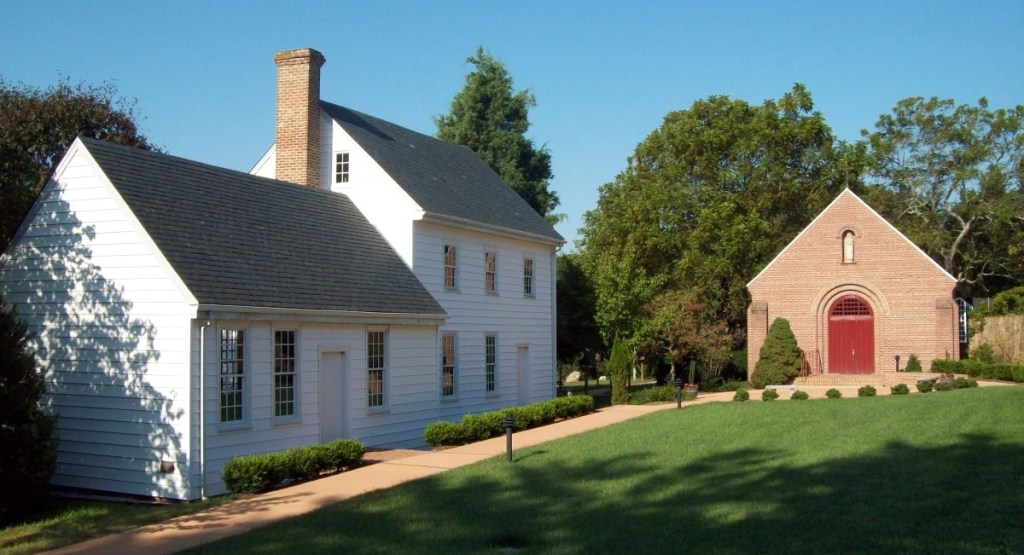
4
Carmel of Port Tobacco, La Plata
This site has a moving story of restoration and renewal, all in God’s good time. Centuries ago, in 1790, Maryland Catholics created this monastery as the first convent of religious women established in the original 13 colonies. The site was abandoned in 1831 as the sisters moved to Baltimore.
This original monastery site remained uninhabited by religious sisters for almost 150 years, until a dedicated campaign to restore the Carmel finally succeeded in 1976. Today there are 10 Carmelite sisters on this original site.
Visitors can participate in the celebration of the Liturgy of the Eucharist, walk through the monastery’s prayer gardens, tour the historic “Old Monastery” buildings, or check out the gift shop.
5
National Shrine of St. Jude, Baltimore
St. Jude is known as the patron saint of impossible causes, and this shrine is the nationwide center of devotion for all those asking for his intercession. People from all over the world visit the Shrine to pray, participate in devotions, and explore the historical and interactive multimedia center.
BONUS SITE
Brick Chapel at Historic St. Mary’s City
This unusual site is special to all American Catholics as the founding place of the Catholic Church in English America. Its history goes back to 1634, when Father Andrew White and other Jesuits who arrived in the Maryland colony established a wooden chapel at this site.
After that chapel was burned in a hostile attack, the chapel was rebuilt, this time of brick. The impressive brick structure served as the focal point of the Catholic faith in Maryland until 1704, when anti-Catholic prejudice forced the Jesuits to dismantle the building and sell the land.
Today, you can visit to see a careful reconstruction of the original Brick Chapel. Although the site is no longer in use as a place of worship, it holds great historical significance:
Constructed in 1667, the Brick Chapel could not have been built in any other place in the English colonial world, where it was illegal to openly practice faiths outside of the Church of England … Although the Brick Chapel was in active use for only about 30 years, its legacy of religious freedom remains vitally important in our own lifetime.
